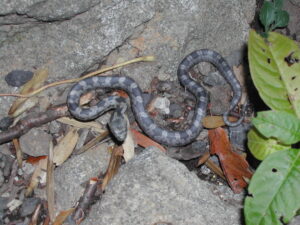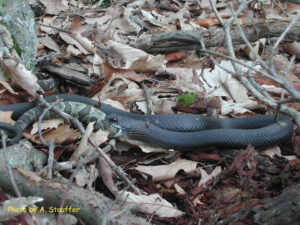
“I just killed that snake,” my neighbor informed me. “It was a copperhead.” I look down to see a dead young black snake lying on the road. I try to use this as a teaching moment and proceed to tell my neighbor that young black snakes have a pattern, are harmless, and help to control the rodent population.
Cut to a state forest where a timber rattlesnake who is attracted to the nice warm, open sunny spot is basking in the middle of the road. The driver of a pick-up truck sees the snake and swerves out of his way so that he is sure to runover and kill the snake.
I understand people’s trepidation with snakes. Afterall, they are portrayed in religion, mythology, and literature as evil creatures who are always up to no good. Part of my job as a wildlife biologist with the Departments of Conservation and Natural Resources (DCNR) is to educate employees, loggers, and visitors on the importance of the noble serpent. For example, snakes help to control rodents who are vectors of Lyme disease and can also decimate the seedlings in a young forest. The toxins in venom from snakes like PA’s timber rattlesnakes, copperheads, and massasauga’s are being researched as potential treatments of illnesses (cancer and chronic pain) and the development of new drugs (anti-inflammatories).

Photo of a young black rat snake. Newborn and juvenile black snakes have a blotchy pattern on their dorsal side.
July 16th is World Snake Day; a day set aside to celebrate and promote awareness of the benefits of snakes. A great way to start to understand their importance in Pennsylvania’s ecosystems is to learn how to identify the different species and the habitats in which they reside. You can visit the PA Herps website to see photos, habitat preferences, and data for the 20+ species of snakes in PA.
You can also help by participating in the Pennsylvania Amphibian and Reptile Survey, where you can report snake sightings as well as sightings of other reptiles and amphibians.

A young timber rattlesnake being eaten by a black racer.
Written by Aura Stauffer
Aura has a B.S. and M.S. from the Pennsylvania State University in Wildlife and Fisheries Science. She has worked with the Environmental Protection Agency, Office of Wetlands and Waterways in Washington, DC as a consultant, and for the Audubon Society at the Audubon Camp in Maine as a marine biology instructor. She worked as an environmental consultant for Gannett Fleming Engineers in Harrisburg, and as the County Inventory Coordinator for The Nature Conservancy, PA Science Office. She is currently employed (since 2002) as a wildlife biologist with the Pennsylvania Department of Conservation and Natural Resources, Bureau of Forestry where she works mostly with non-game species management on state forest lands. She also volunteers with Project Owlnet where she bands saw-whet owls at the Kings Gap State Park banding station. Aura’s other interests include bike riding and becoming an Adirondacks High Peaks 46er.




